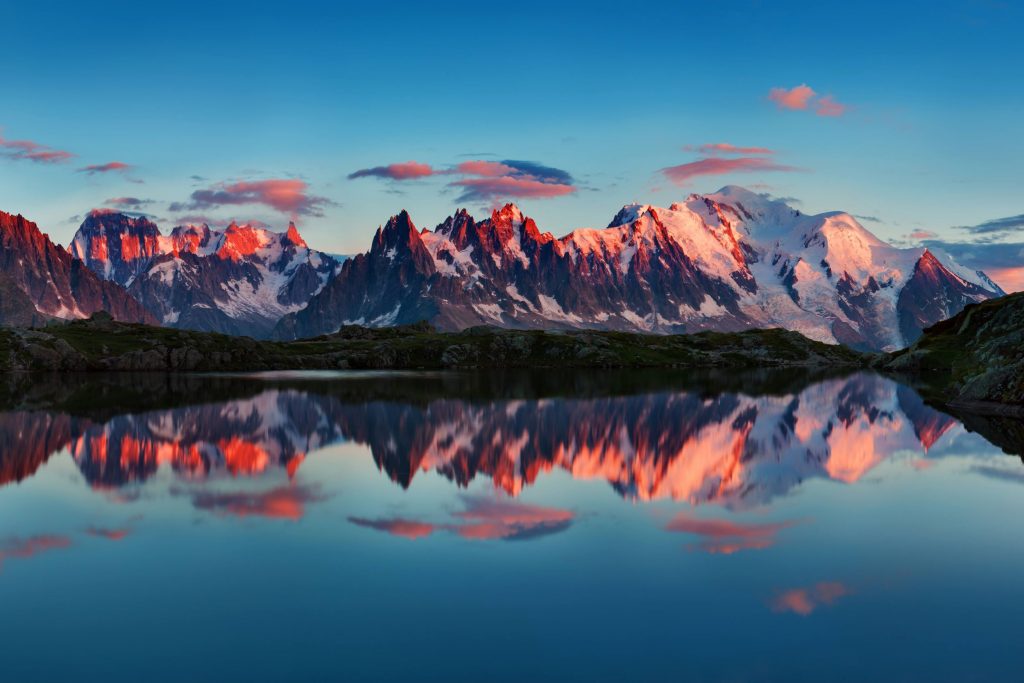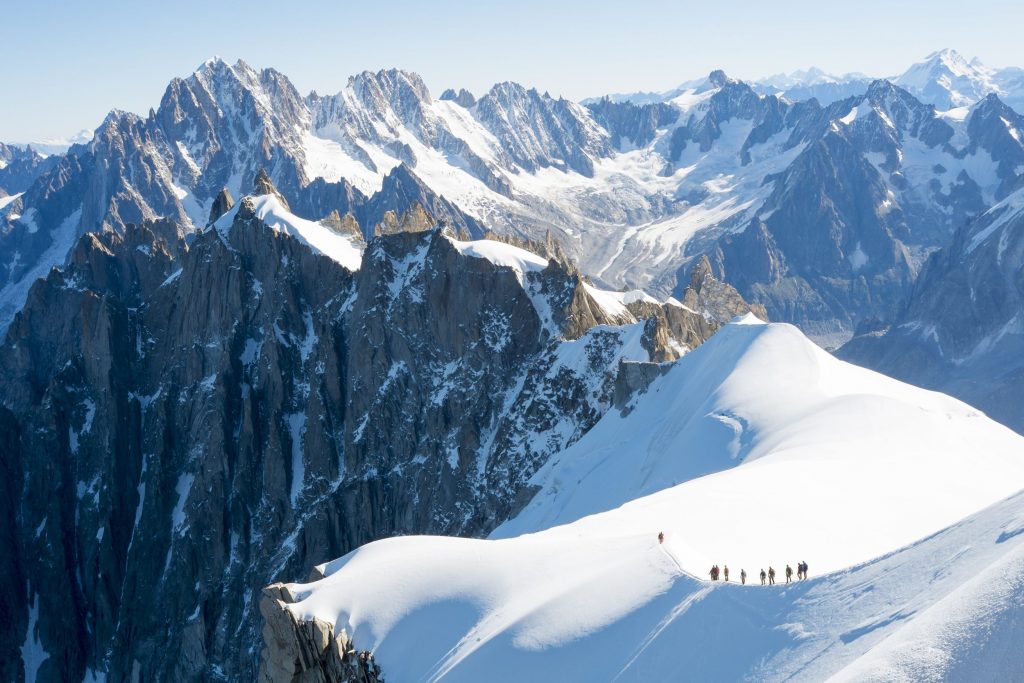
ASCENT OF MONT BLANC. HOW TO CONQUER THE ROOF OF EUROPE?
Sooner or later, the eyes of many mountain hiking enthusiasts turn towards Mont Blanc. The Roof of Europe entices with its height, wilderness, and Alpine majesty, but at the same time, it is a relatively "accessible" peak - it's no wonder that the promise of an exciting climb attracts up to 20,000 tourists every year. How to organize an ascent of Mont Blanc? How to prepare for it and what should you know about the White Mountain before starting to plan your expedition? Check it out!
WHAT WILL YOU LEARN FROM THIS POST?
- Ascent of Mont Blanc - can an inexperienced person handle it?
- Ascent of Mont Blanc with a guide or without?
- Is a permit required to climb Mont Blanc?
- How much time should be reserved for conquering the White Mountain?
- How long should acclimatization take before climbing to the Roof of Europe?
- How to plan accommodation near Mont Blanc?
MONT BLANC - A BRIEF GEOGRAPHY LESSON
Mont Blanc (from Italian Monte Bianco, meaning 'White Mountain') is the highest peak in the Alps, located on the border between Italy and France. Its current elevation is 4,808.72 meters above sea level - "current" because this value is still changing. Every year, the summit rises by 2-3 millimeters, and the thickness of the ice cap covering it also varies. At the beginning of the 21st century, it was decided to measure its height every two years. The current measurement is from 2017.
It is still not possible to determine definitively whether Mont Blanc is the highest peak in Europe because there is an ongoing debate about the geographical boundary between Europe and Asia. Depending on the interpretation, the title of the highest mountain in the Old Continent may also belong to Mount Elbrus in the Caucasus (5,642 meters above sea level). To avoid questioning this achievement, climbers collecting the Seven Summits crown choose to conquer both mountains.
One thing, however, is beyond doubt - at the sight of the massive, menacing, perpetually snow-covered ridge of Mont Blanc, the heart of every mountain lover beats faster. The potential loss of the title of the highest peak in Europe certainly does not diminish the majesty of the White Mountain, nor does it discourage the thousands of tourists who attempt to climb it every year.

MONT BLANC SEASON
The season for conquering Mont Blanc lasts from June to September, with the peak months falling during the summer - late spring and early autumn already have more snow. The mountain, although heavily visited, can be unpredictable and unforgiving for climbers. Even in the middle of a hot summer, the temperature above 4,000 meters almost always drops to -15°C, and snowstorms can occur at the summit. This can be troublesome because in the valleys, temperatures can reach up to 30°C, so tourists' clothing must be suitable for extremely diverse conditions.
In theory, a week should be enough for acclimatization and climbing to the summit of Mont Blanc. However, it's worth allowing an additional 2-3 days as a reserve for unforeseen weather changes.
EXPERIENCE AND FITNESS
The number of 20,000 tourists attempting to conquer Mont Blanc each year may suggest that reaching the summit is not difficult. However, this is a misleading impression. The White Mountain, although not technically difficult, can reveal its more dangerous side. When planning an expedition, one must consider weather changes, the risk of getting lost in cloud cover, or falling into crevasses. Setting off on the trail without experience, preparation, and alpine equipment skills is asking for trouble.
A safe ascent of Mont Blanc requires completing a high-mountain tourism or mountaineering course. The ability to properly secure oneself and use crampons and ice axes, as well as knowledge of acclimatization principles and how to behave in the face of avalanches or worsening conditions, is a reasonable minimum for tourists heading to the Alpine trails.
Of course, Mont Blanc can also be conquered with a guide who can assist with their experience in a crisis. However, this doesn't change the fact that only tourists familiar with mountains, adequately conditioned and physically fit, should embark on the trail. It's worth working on improving one's endurance through running or swimming training several months before the planned expedition.
TRANSPORTATION
The starting point for reaching the Roof of Europe is the French town of Chamonix, located near the borders of France, Italy, and Switzerland. The easiest way to get there is by plane - from Warsaw to Geneva, and then by train to Chamonix. By car, the journey through Germany and Switzerland should take about 15 hours (the Wrocław-Chamonix route is approximately 1,270 km long).

ROUTES TO THE MONT BLANC SUMMIT. HOW TO PLAN THE TREK?
GOUTER ROUTE
The most popular route is the so-called Gouter Route, also known as the Royal Route, French Route, or simply the classic route. It starts in the town of Les Houches, about 8 km away from Chamonix, where a cable car operates. After reaching the Bellevue station (1800 m), you can transfer to a cogwheel train and ride up to an altitude of 2380 m, to the Nid d'Aigle station, which is the main starting point of the ascent. Along the Gouter Route, there is the Tete-Rousse refuge (3167 m), where most climbers attempting to reach the summit stay for acclimatization overnight. During the hike to the top of the White Mountain, you will also pass the Refuge du Gouter (3835 m), which is open from June to September, and the Vallot emergency shelter (4362 m). It is important to note that planned bivouacs are not allowed in the Vallot shelter, as it serves as a rescue shelter for climbers in case of deteriorating conditions.
Since 2019, in order to climb Mont Blanc, it is necessary to book accommodation at either the Tete-Rousse or Gouter refuge. This is done to limit tourist traffic in this area of the Alps.
The most difficult and risky part of the classic route on Mont Blanc is the passage through the so-called Corridor of Death, also known as Rolling-Stone. It is a couloir descending from the Aiguille du Gouter peak, and its steep ridge often carries rocks, boulders, ice blocks, and avalanches. This statistically accounts for the highest number of accidents within just a 50-meter section, so it should be traversed as quickly as possible, with the mandatory use of a helmet and securing with a rope.
The Gouter Route is rated as PD (Peu Difficile), which means "fairly difficult" on the alpine scale. Although it does not require technical climbing, there are challenging sections where rope protection is needed. The ascent to the Roof of Europe should be started around 2 a.m.
3M ROUTE
Slightly more difficult (PD+) is the Three Mountains Route - Les Trois Monts, abbreviated as 3M. The journey begins in Chamonix, where a cable car operates to the Aiguille du Midi station (3842 m). At this altitude, you can spend the night at the Cosmiques refuge. To reach Mont Blanc via this route, you have to traverse the glacier and climb two peaks: Mont Blanc du Tacul and Mont Maudit. The entire route is about 17 km long with an elevation gain of approximately 2000 m, but the breathtaking views from it are definitely worth the effort.
ITALIAN ROUTE
Mont Blanc can also be attempted to be conquered from the Italian side, known as the Papal Route (established by Achille Ratti, later Pope Pius XI, in 1890). It is considered more challenging than the French routes but is significantly less crowded. The route starts in the Veny Valley and leads through the Gonella refuge (3017 m), and then across the Dome glacier. During the summer months, many crevasses open on the glacier, making rope protection necessary. In the vicinity of the emergency Vallot shelter, the Italian route merges with the French route. Tourists who arrange for return transportation in advance can descend from the summit of Mont Blanc towards Chamonix, although the return via the Papal Route is more difficult, longer, and much more exhausting.
Although perhaps "on paper" climbing Mont Blanc may not seem difficult, in reality, it requires significant experience, proper preparation, and very good physical condition. After all, it is nearly a 5,000-meter peak! Underestimating its power would be unwise. In our next post from the series, "Climbing Mont Blanc - What Equipment Do You Need?", you can read about what to bring to Mont Blanc to be prepared for any eventuality.
Or perhaps a different direction? "Climbing Mount Elbrus - How to Organize Such an Expedition?"
Photo source: shutterstock.com